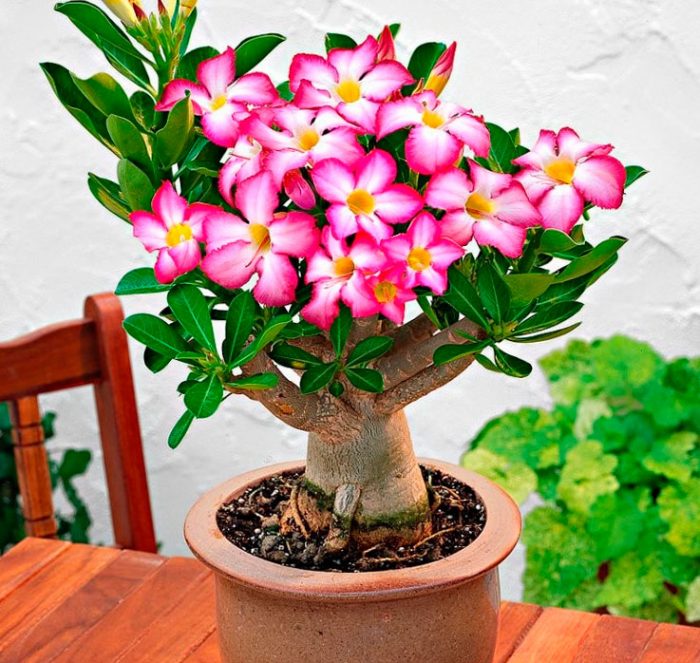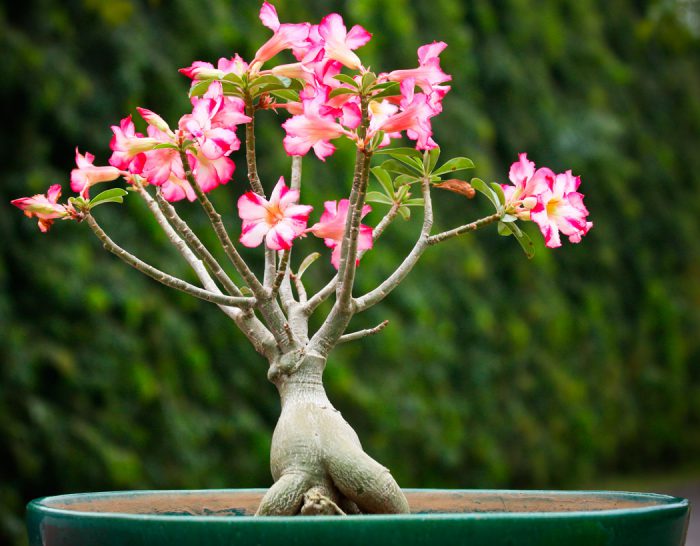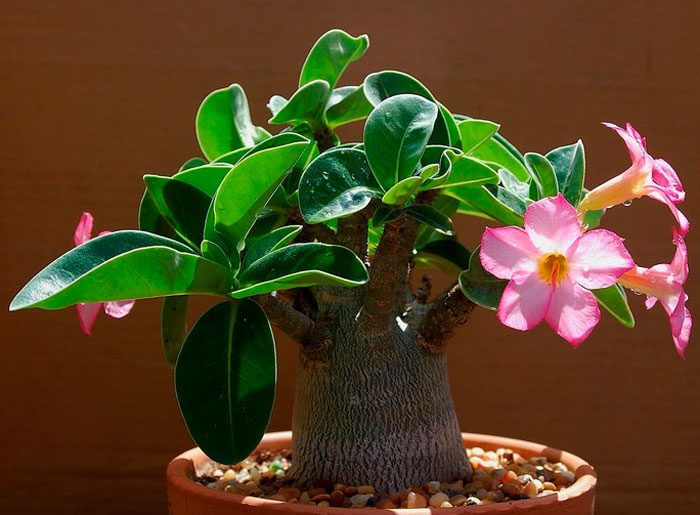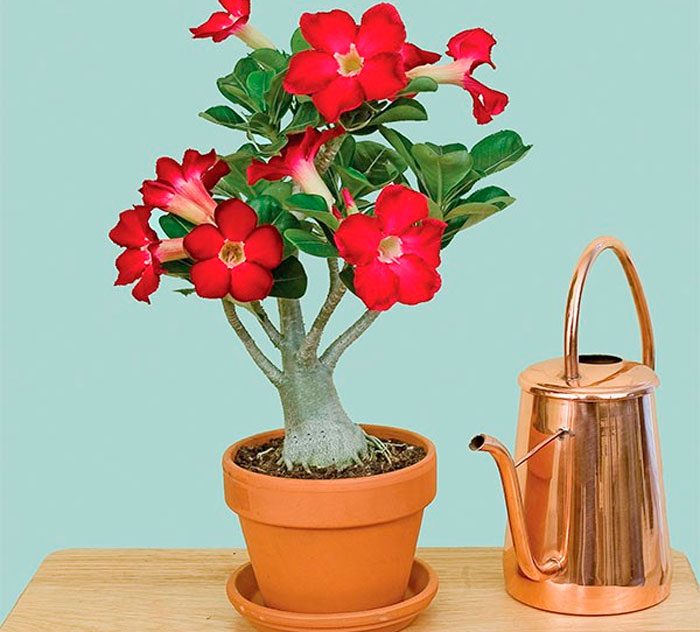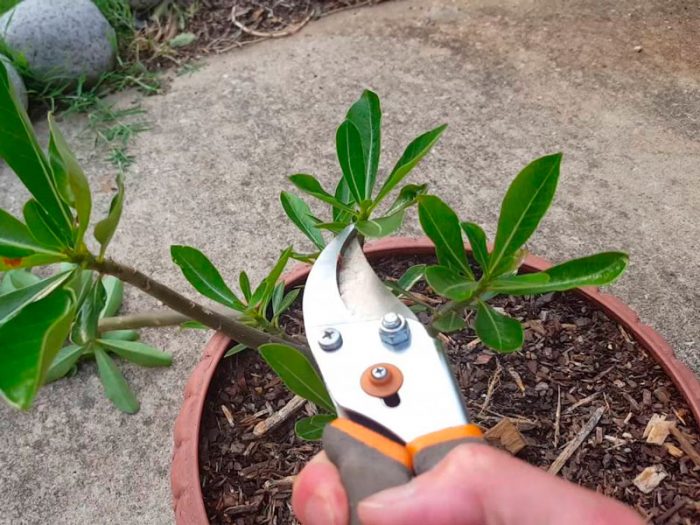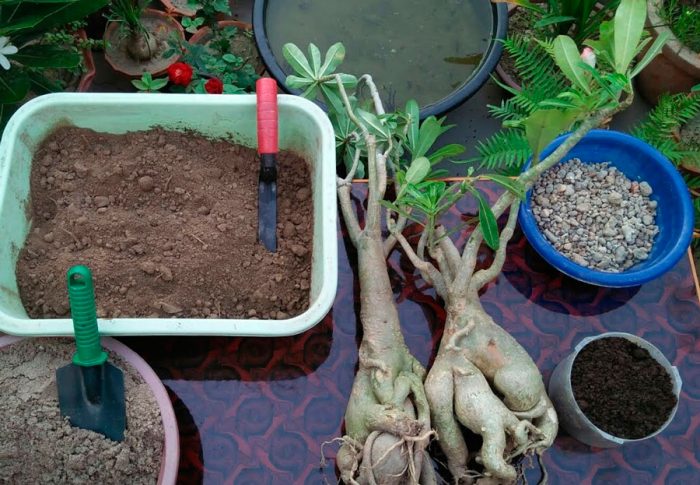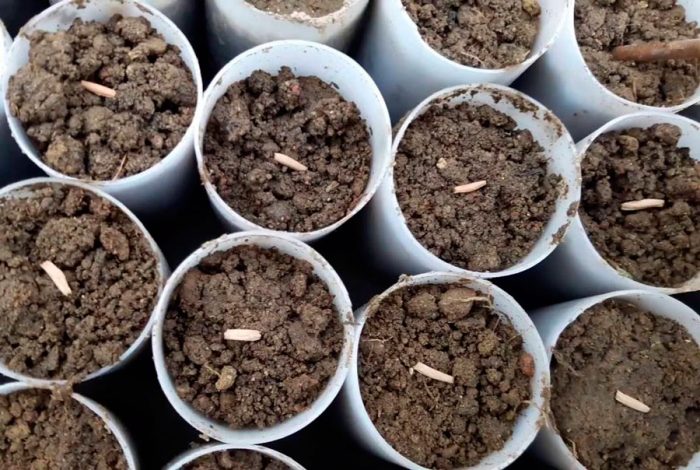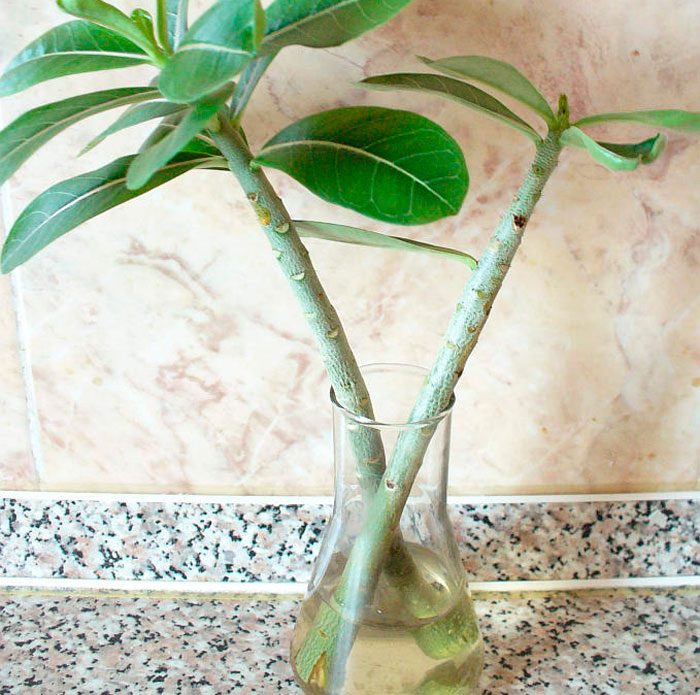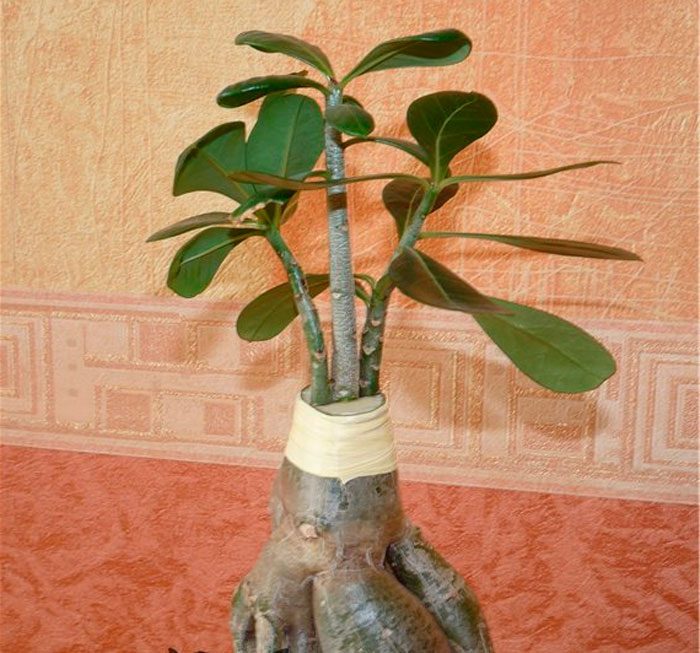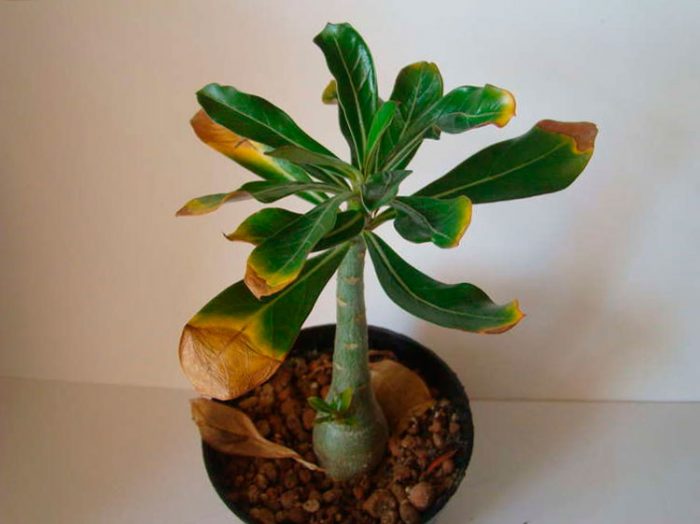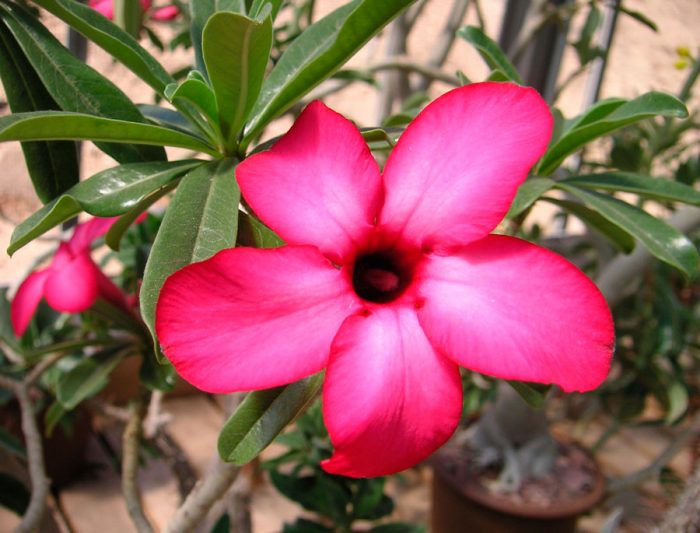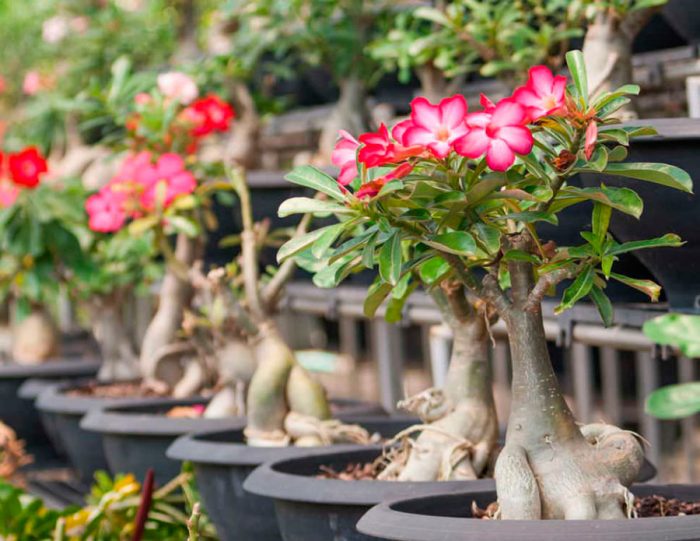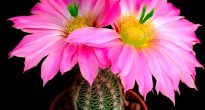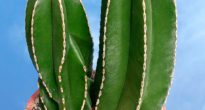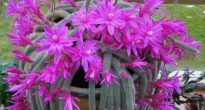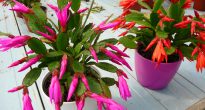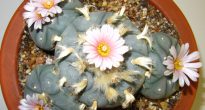The plant adenium (Adenium) is a member of the Kutrov family. This genus contains 5 species. This succulent is found naturally in Central and South Africa. In indoor conditions, such small trees or shrubs reach a height of about 0.35 m. The trunk of this flower is thick. The surface of glossy sheet plates is velvety. Quite large flowers are painted white or dark crimson. Such a plant has many other names among the people, the most popular is "Desert Rose", because this flower has a resemblance to a rose.
Content
Brief description of cultivation
- Bloom... It blooms in April – July and September – October, but in some cases it lasts more than 6 months.
- Illumination... Needs bright sunlight.
- Temperature regime... During intensive growth - from 25 to 30 degrees, during rest - from 12 to 15 degrees.
- Watering... Carried out only after the soil mixture is completely dry.
- Air humidity... It should be increased, especially during the period of intensive growth.
- Fertilizer... They are fed throughout the growing season once every 4 weeks, for this they use mineral fertilizers for indoor flowering plants.
- Dormant period... November – March.
- Transfer. Young bushes need to be replanted every year, and adults only when needed.
- Soil mixture... Sod soil mixed with coarse expanded clay or with broken bricks.
- Reproduction... Generative (seed) method or vegetative: cuttings, grafting or layering.
- Harmful insects... Scabbards, mealybugs, spider mites.
- Diseases... The culture is highly resistant to disease. However, the bush may begin to lose foliage due to a draft, a sharp drop in temperature and a sudden change in keeping conditions.
- Properties... The sap of the plant is poisonous.
Adenium care at home
Illumination
When growing adenium at home, it needs bright sunlight, but it does not need to be shaded. Therefore, it is recommended to place it on a south-facing window.After the end of winter, when there was enough light, the bush will need to be accustomed to the direct rays of the sun gradually, otherwise burns may form on its stem. Another flower must be shaded if direct sunlight falls on it for more than 5 hours a day.
Temperature regime
When growing such a crop at home, in the summer it needs to provide an indoor air temperature of 25-30 degrees. Experts recommend moving adenium outside in the summer, where it needs to be placed in a place that has reliable protection from rain.
In order for the flower to begin a dormant period, it is necessary to reduce the air temperature, as well as reduce the duration of lighting. During this period, the foliage turns yellow and flies around. In winter, in the room where the flower is located, the air temperature should not be lower than 10 degrees, while it feels best at this time at a temperature of 12-15 degrees. Make sure that the roots are not overcooled, otherwise the bush may die.
How to water
When caring for a flower grown indoors, he should ensure timely watering. This procedure is carried out immediately after the substrate in the container is completely dry. In winter, watering should be very scarce and rare. If in winter adenium is kept at an air temperature of 15–20 degrees, then it is watered only after the substrate has completely dried out. If the bush hibernates in a cooler place, watering is carried out extremely rarely or it is completely stopped. Young bushes need to be watered very carefully. When the bush starts growing for the first time in the spring, it will need to be watered 15–20 days after the buds appear and the bush begins to grow.
Spraying
During the period of intensive growth, the bushes need to be moistened with a fine sprayer. After the flowering begins, the bushes need to be moistened very carefully, since the liquid should not be on the surface of the flowers.
Top dressing of adenium
Top dressing of adenium is carried out in the spring, summer and at the beginning of the autumn period, they do this no more than 1 time in 4 weeks. To do this, use fertilizer for indoor plants, while the concentration of the solution should be from 1.5 to 2 percent.


Watch this video on YouTube
Pruning
Pruning of bushes is carried out only if necessary, and this is done only in spring. To form a bush in the form of a tree, you need to shorten the side branches by 1/3 of the length. To form a bush, you need to cut it below. The formation of adenium takes quite a long time, and it is quite difficult, but if everything is done correctly and in a timely manner, the result will be impressive.
Transfer
Young plants are transplanted annually in the spring, and adult specimens are subjected to this procedure only if necessary. Experts recommend choosing a light-colored pot for planting, this will help protect the root system from overheating. For planting adult plants, choose wide and small containers. After transplanting, the bush should be watered only after 4–6 days, during which time the roots will have time to dry out.
The substrate should be loose, and it should consist of sod and leafy soil, as well as coarse sand (1: 1: 1), and a small amount of charcoal should also be added to it. The soil mixture for transplanting an adult plant should include a large amount of sod land, and broken bricks are also added to it. Don't forget to make a good drainage layer at the bottom of the pot.
Virulence
Such a plant contains poisonous juice, in this regard, after work with it is over, hands must be thoroughly washed with soap. The flower should stand in a place that is inaccessible to animals and children. If you decide to decorate your home with adenium, then this must be taken with full responsibility in order to avoid poisoning.
Reproduction methods
Growing adenium from seeds
With prolonged storage, the seed material of adenium loses its germination capacity; therefore, only fresh seeds should be used for sowing. They are sown in the last winter or first spring weeks.
The container is filled with a substrate consisting of charcoal, sand and vermiculite. The seeds need pre-sowing preparation, for this they are placed in a solution of potassium manganese for 30 minutes, and then they are kept in a lukewarm solution of Zircon for several hours. The seeds must be spread over the surface of the substrate, and then they are covered with a thin layer of soil mixture. Crops are placed in a warm place (from 33 to 35 degrees), a week later seedlings will appear. If the crops are in a cooler place, then the seedlings may appear later or this will not happen at all. When the plants appear, they will need to be illuminated with fluorescent lamps, they will also need to provide regular ventilation, while the air temperature in the room should be at least 18 degrees.
After the flower has formed the first two true leaf plates, they gradually begin to look after it like an adult specimen. And when 2 more leaf plates are formed, the seedlings should be cut into individual containers.
Cuttings
Reproduction by apical cuttings is a rather complicated process, since they can easily rot. Cuttings are carried out in summer or spring. Cuttings must be divided into parts, the length of which should be about 12-15 centimeters, then they must be dried by treating the cuts with charcoal. In order for the cuttings to take root, it is necessary to use perlite, a mixture of sand and charcoal or small expanded clay. It is necessary to pour sand or small charcoal around the root collar, thanks to this, the base of the stem will not rot. Cuttings need bright sunlight, while the air temperature should never be below 25 degrees. Waterlogging of the soil should not be allowed. If everything is done correctly, the cuttings will take root after 4 or 5 weeks.


Watch this video on YouTube
How to propagate by layering
In May and June, this succulent can be propagated by air layers. Take a very sharp knife and make a circular incision on the shoot with it (the stem should be 20 mm across). After the incision site dries up, it should be treated with a solution of a product that stimulates root growth. Wrap this place with sphagnum moss, which must be wrapped on top with opaque cellophane. Remember to keep the moss wet regularly. After about 4 weeks, the roots should appear, then the layers are separated from the mother plant and planted in a container filled with a substrate intended for an adult bush.
Reproduction by grafting
To inoculate such a culture, you can use another adenium or Oleander. Make cuts in the scion and rootstock with a very sharp knife, then they are combined with each other, and then the plants are firmly held together (you can use a special spray). Make sure that the air temperature in the room is not less than 30 degrees, the air humidity should be high, and you also need bright lighting. The new bush must be protected from direct sunlight, and the shoots that have appeared on the rootstock must be cut off immediately.


Watch this video on YouTube
Diseases and pests of adenium
Yellowing and flying around foliage
Adenium can begin to lose foliage due to the fact that the room is very cold, or it was placed in unusual conditions, and it can also happen due to a draft. To save a flower, you need to start taking proper care of it.
Falling foliage in autumn is considered quite normal, as the plant prepares for a dormant period.
Harmful insects
Such a culture is highly resistant to pests.But in some cases, ticks, scale insects and mealybugs can settle on the bush.
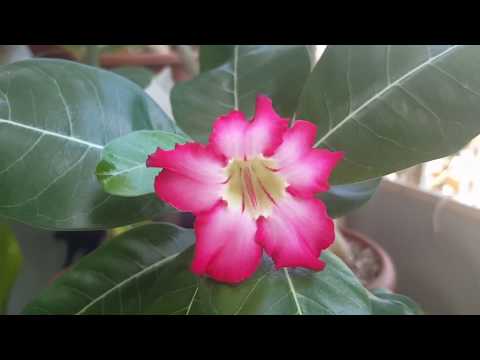

Watch this video on YouTube
Varieties of adeniums with photos and names
Adenium boehmianum
This species differs from the rest in the color of the flowers. In pinkish-lilac or bluish-white flowers, the pharynx and corolla tube are purple.
Adenium multiflorum (Adenium multiflorum)
The height of the bush is about 2.5 meters. The trunk branching at the top lignifies over time. Flowers of this type are similar to the flowers of adenium obessum, but there are more of them.
Adenium obesum (fat) (Adenium obesum)
The height of such a slow-growing plant is about one and a half meters. The gray-brown trunk, branching in the upper part, becomes lignified over time. Greenish-gray leathery leaf plates grow at the ends of the branches, their length is about 10 centimeters. In the summer, corymbose inflorescences appear, they include white, red or pink flowers, reaching 60 mm in diameter.
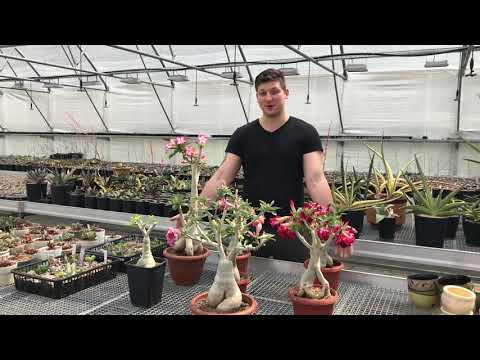

Watch this video on YouTube

